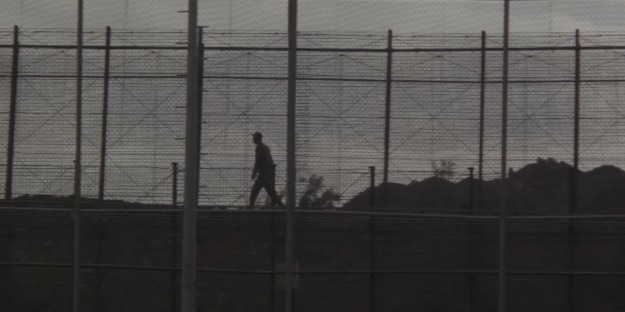It begins with a slow pan across a bay. It passes what looks like a cruise ship. At a point further ahead, the camera stops and starts to move back the other way and pauses at the cruise ship. We may be abroad but don’t expect any recognisable landmarks. We are pretty far from a Woody Allen-style European sojourn. Geographically, this is difficult to place. It looks like Spain, and technically it is. This is Melilla, a Spanish enclave that borders Morocco. There follows day and nighttime footage of migrants trying to get over or through the fence. There is a stunning shot of the almost physically daunting road that seems to go on an incline forever alongside the fence. Juxtaposed with the footage of the fence we see beaches and palm trees, a Spanish city fever dream for broken people.”
Tadhg O’Sullivan would be known to anyone who is a fan of the superb Irish filmmaker Pat Collins. O’Sullivan edited his last two films, Silence and Living in a Coded Land. If you are at all familiar with the style and if you are a fan (if you have not seen them, do!) the style of The Great Wall will be a little bit familiar. Traditional narrative and talking heads make way for a visual poem with sections from the ‘Building of the Great Wall of China’ by Franz Kafka spoken over modern-day images set to a superb classical or electronic soundtrack. A lot of this is created by the multi-talented O’Sullivan, who serves as director, producer, editor and sound designer (most probably other jobs too). The footage in the security rooms in Melilla is stark. O’Sullivan’s camera moves with a quiet and slow speed that almost suggests he is trying to become invisible. And we are faced with the desperate, ever willing to risk the loss of their own lives to improve them. We see migrant camps and young men tired but defiant for a better life, and yet their eyes betray their suffering. These are men who grow bored of doing nothing, which breeds resentment. What will they be doing in 5 or 10 years with that resentment? These cramped camps are shockingly contrasted with the squeaky clean major European cities that follow. These are cities that are stripped of recognition by O’Sullvan’s refusal to give us geographical comfort and the stunning cinematography of Feargal Ward who finds spaces that are both beautiful and alienating. We feel the weight of the CCTV that follows people around here, cameras in theory that are protecting us but are in fact doing the opposite. O’Sullivan asks these questions either silently or with the voice over from Kafka that matches up in some surprising ways with what is being depicted on screen.
O’Sullivan has created one of the best documentaries you will see this year. Ireland continuously punches above its weight in documentary filmmaking, and O’Sullivan has produced something truly wonderful. The Great Wall is also remarkably timely with its visits to rising political temperature in Athens. It has a deeply humane feeling towards migrants which contrasts sharply with the language used to dehumanise the people in Calais or on flimsy boats in the Mediterranean. Here is a documentary that has deeply unsettling things to say about governments. The walls that are being erected may not even be physical. The wealth gap is a barrier that will never be cleared by the majority. There is a truly outstanding sequence in the film that is the result of three different events spliced together that shows the militarisation of the police (again so timely as we recall armoured ‘cars’ rolling down the streets of Ferguson). This is not only great filmmaking, but important filmmaking. Tadhg O’Sullivan is a director to watch.

